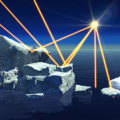Data Puzzles Collections

On a Budget
Rising global temperatures over the past century indicate that Earth’s energy budget is out of balance. However, not all warming is equal. The Arctic, a vast frozen ocean, is heating up faster than the global average! In this Data Puzzle, students analyze incoming shortwave and outgoing longwave energy to and from the Arctic to investigate the question, "Why might the Arctic be warming faster than other places on Earth?" Figure credit: NSIDC.

To Reflect or Not to Reflect
The color of Earth's surface determines how much of the Sun's energy is reflected or absorbed (albedo), with lighter-colored surfaces being more reflective than darker-colored surfaces. In this Data Puzzle, students analyze authentic Arctic datasets (albedo and sea ice extent) to investigate the question, "How might the Arctic’s albedo be affected by the observed decline in sea ice?" Figure credit: NASA.

It's All Connected
What makes the Arctic climate system so unique is the sea ice, which influences the Arctic climate in many ways. In this Data Puzzle, students analyze a humidity dataset captured by a drone during the historic MOSAiC Arctic expedition to investigate the question, "What effect, if any, do leads (cracks in the sea ice) have on the transfer of moisture between the Arctic Ocean and atmosphere?" Image credit: Calle Schonning.

Balancing Act - Changes to the Greenland Ice Sheet
Since the early 2000s, the Greenland Ice Sheet’s mass balance has been consistently negative, meaning more mass is being lost than gained. But this change in mass balance hasn’t always happened at the same rate. In this Data Puzzle, students analyze temperature, snowfall, and meltwater rate datasets to investigate the question, "What factors are contributing to changes to the Greenland Ice Sheet in recent decades?"
Pagination
- Previous page
- Page 2